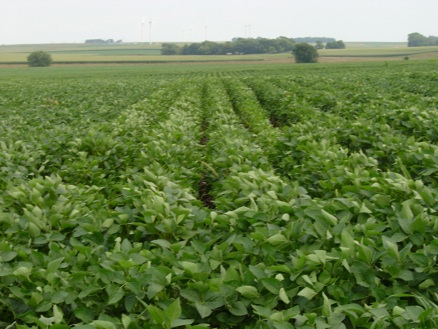Purification and Seed Increase
 Uniformity and consistency of plants and seeds are important characteristics of a soybean variety. Growers want uniformity in the field in order to harvest the crop efficiently. End-use processors want uniform seed in order to process it more efficiently. Therefore uniformity is an important consideration in the breeding and development of a new soybean variety at Galena Genetics.
Uniformity and consistency of plants and seeds are important characteristics of a soybean variety. Growers want uniformity in the field in order to harvest the crop efficiently. End-use processors want uniform seed in order to process it more efficiently. Therefore uniformity is an important consideration in the breeding and development of a new soybean variety at Galena Genetics.
As soybean goes through consecutive generations of self-pollination, plants in each succeeding generation become more homozygous. In other words, the two alleles of each gene will become identical. In order to insure genetic uniformity within new soybean varieties, we conduct a genetic purification process concurrent with the advanced stages of our yield testing program. This process requires a minimum of two generations to complete. The exact generation in which this process starts may vary. However the concept is the same.
The procedure is as follows. An F6 plant is harvested from an F3:6 line, and the resulting F6:7 seed is planted in a row the following season. From that row, all the plants are harvested individually, and resulting F7:8 seeds are planted in rows next to each other the next season. All the F7:8 rows derived from that individual F6 mother plant are grown side by side and carefully observed to ensure they all look alike. Molecular genetic markers are also used to compare these rows. Any rows which are not like the other rows are eliminated prior to harvest. The remaining rows are machine harvested separately from each other, and the F7:9 seed from all the rows is compared. Any F7:9 seed that does not look like seed from the other F7:9 rows is eliminated. Seed from only the remaining rows is bulked to form breeder seed of the new variety. Depending upon the number of rows saved, this may only be 20 – 50 lbs of seed. This is referred to as breeder seed, and is the basis of all subsequent seed production of a new variety.
Obviously, in order to generate sufficient quantities of seed for commercial sale, the breeder seed must be increased. A portion of the breeder seed (about 50%) is used to plant a breeder seed increase the following generation. The breeder seed increase fields are carefully monitored for flower color, pubescence color, plant height, and other characteristics throughout the growing season. Any off-type plants are rogued from the field in order to eliminate contamination at harvest. One breeder seed increase will produce about 10 – 50 bushels of foundation seed of the new variety, depending on the size of the increase. The resulting foundation seed is used to plant a foundation seed increase the following generation. The resulting 500 – 2500 bushels of seed is used for sales introduction. When foundation seed increases are harvested, it is crucial that the combine is cleaned and flushed out well before harvesting each variety increase.
From a breeding and development point of view, the process of developing a new identity-preserved variety may end here. However maintaining genetic purity of an IP variety is critical in commercial production just like it is in foundation seed production and increase. Growers who contract IP production of Galena Genetics varieties must be vigilant in maintaining the purity of all IP varieties at planting time as well as harvest. Thorough planter cleanout prior to planting IP varieties is critical to maintaining varietal purity. Thorough combine cleanout and flushing are also essential to remove any other soybean varieties from the combine before harvesting the bulk of an IP variety.
